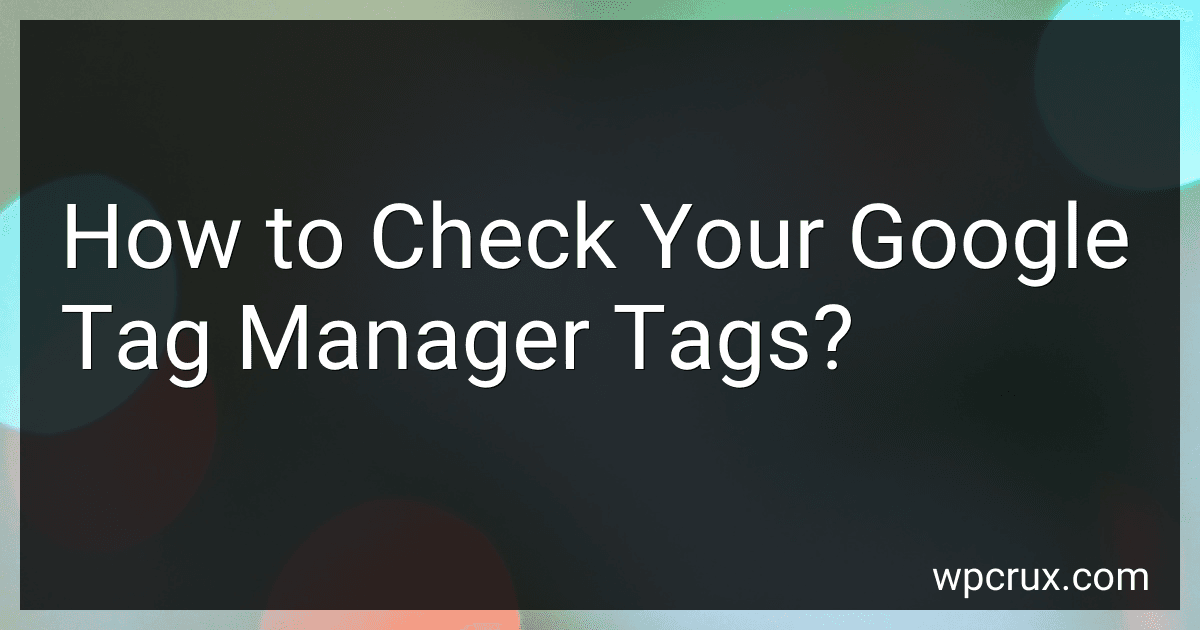Best Google Tag Manager Tools to Buy in October 2025
To check your Google Tag Manager tags, you can follow these steps:
- Go to the Google Tag Manager website and log in with your Google account credentials.
- Once logged in, you'll be directed to the Google Tag Manager dashboard. Select the container you want to view tags for.
- In the left-hand menu, click on "Tags." You'll see a list of all the tags associated with the selected container.
- Click on a specific tag to view its details. This will allow you to check the configuration and settings of that particular tag.
- You may see options such as tag name, tag type, trigger configurations, and other settings associated with the tag.
- If you want to check if the tag is firing properly, you can click on "Preview" mode at the top of the dashboard. This will activate the preview mode, allowing you to simulate tag firing and see if the tags are working correctly.
- To test tag firing on a live website, you can install the Google Tag Assistant browser extension. It will help you identify the tags firing on a specific webpage and troubleshoot any potential issues.
- After ensuring the tags are firing correctly, you can save and publish the changes in Google Tag Manager.
By following these steps, you can effectively check your Google Tag Manager tags to ensure the proper implementation and functioning of your tags on your website.
How to add a new tag in Google Tag Manager?
To add a new tag in Google Tag Manager, follow these steps:
- Sign in to your Google Tag Manager account.
- Select the desired container from the Container drop-down.
- Click on "Tags" in the left-hand navigation menu.
- Click on the "New" button to create a new tag.
- In the Tag Configuration section, choose the appropriate tag type. These can include Google Analytics, Google Ads, Facebook Pixel, etc.
- Configure the settings and options for the selected tag type. This may involve entering tracking IDs, conversion IDs, enabling/disabling certain features, etc.
- Set up the triggering conditions for when you want the tag to fire. This can include triggers such as pageviews, clicks, forms submissions, etc. You can either use existing triggers or create new ones.
- Click on "Save" to create the new tag.
- Test the tag to ensure it's functioning correctly by using the "Preview" mode.
- Once you're satisfied with the tag setup, click on "Submit" to publish the changes to your live GTM container.
Remember to follow best practices and adhere to your organization's policies and guidelines when adding tags to your website.
How to set up Google Tag Manager tags?
To set up Google Tag Manager tags, follow these steps:
- Sign in to your Google Tag Manager account.
- Click on "Tags" in the left sidebar.
- Click on the "New" button to create a new tag.
- Give your tag a descriptive name.
- Click on the "Tag Configuration" section to choose the type of tag you want to set up. There are various options available, such as Universal Analytics, Google Ads Conversion Tracking, Facebook Pixel, etc.
- Configure the settings for the selected tag type. This may include adding your Google Analytics Tracking ID, conversion IDs, or other relevant information for the specific tag type.
- Click on the "Triggering" section to specify when the tag should fire. You can choose from built-in trigger templates or create custom triggers based on specific events or interactions on your website.
- Review and save your tag.
- Once the tag is saved, click on the "Submit" button in the top right corner to publish your changes. It is important to publish your changes for them to take effect on your website.
Remember to test your tags after setup to ensure they are functioning correctly.
How to track a specific button click using Google Tag Manager?
To track a specific button click using Google Tag Manager, follow these steps:
- Create a new Tag in your Google Tag Manager container for the specific button click tracking.
- In the Tag configuration, select the Tag type that corresponds to the analytics platform you are using, such as Google Analytics.
- Configure the Tag settings according to your analytics platform's requirements, such as providing the tracking ID for Google Analytics.
- Set the Trigger for the Tag to fire on the specific button click. There are two options for creating a Trigger: a. Predefined Triggers: If your button has built-in classes or attributes that uniquely identify it, you can create a trigger by selecting "Click - All Elements" as the trigger type and applying conditions such as "Click Classes" or "Click ID" to match the button. b. Custom Triggers: If your button doesn't have unique classes or attributes, you can use custom JavaScript to identify and trigger the button click. To do this, create a custom HTML Tag that contains the JavaScript code to identify the button, and then create a new trigger that fires on this custom HTML Tag.
- Save and publish your changes in Google Tag Manager.
- Test the tracking by visiting your website and clicking the specific button. Use the Google Tag Assistant Chrome extension or similar tools to ensure that the Tag fires correctly and sends the button click data to your analytics platform.
By implementing these steps, you should be able to track the specific button click using Google Tag Manager and gather data in your analytics platform for further analysis.
How to remove unused tags from Google Tag Manager?
To remove unused tags from Google Tag Manager, follow these steps:
- Login to your Google Tag Manager account.
- Select the respective container where the tags are located.
- Under the "Tags" section on the left side menu, click on the "All Tags" tab.
- Locate the tag that you want to remove. The unused tags will not have any associated triggers or be used in any other tag configurations.
- Click on the tag that you want to remove to open its configuration.
- In the top right corner of the tag configuration page, click on the "Delete" button.
- A confirmation dialogue box will appear. Click on "Delete" to confirm the removal of the tag.
- Repeat the process for any other unused tags that you want to remove.
By following these steps, you can easily remove any unused tags from your Google Tag Manager account, keeping your tag configurations organized and decluttered.
What are the different types of tags in Google Tag Manager?
There are several types of tags that can be used in Google Tag Manager:
- Universal Analytics Tags: These tags are used for tracking website analytics using Google Analytics.
- Google Ads Conversion Tracking Tag: This tag allows you to track conversions from Google Ads campaigns.
- Remarketing Tags: These tags are used for creating and managing remarketing lists for Google Ads.
- Floodlight Counter and Sales Tags: These tags are used for tracking conversions and other actions in Google Marketing Platform.
- Custom HTML Tags: These tags allow you to add your own custom HTML code to your website, such as tracking codes from other tools or platforms.
- Custom Image Tags: These tags can be used to fire an image pixel or a script to track specific events or actions on your website.
- Timer and JavaScript Error Tags: These tags can be used to measure page load time or track JavaScript errors on your website.
- AdRoll SmartPixel Tags: These tags are used for tracking conversions and retargeting with AdRoll.
- LinkedIn Insight Tag: This tag enables conversion tracking and website analytics for LinkedIn Ads.
- Many more: Google Tag Manager supports a wide range of tags, including tags for various advertising platforms, social media platforms, e-commerce platforms, and more.
These are just a few examples, and the list of available tags in Google Tag Manager continues to grow as new integrations and features are added.



